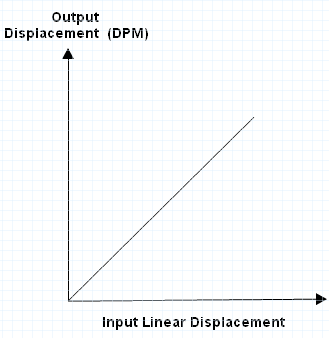LVDT primary, secondary windings are connected such that applied voltage on primary and induced voltage on secondary are 180° phase opposition as shown in the figure. If the core is moved to the left of null position more flux will link S1 than that of S2. A resultant voltage (Es1 – Es2) which is in phase with primary voltage will appear across the output.
If the core is moved to the right of null position, the resultant voltage (Es1 – Es2) is 180° out of phase with primary voltage which will be the output. Thus the output voltage is a measure of displacement. The variation of output voltage with the displacement is as shown below:
Linear Variable Differential Transformer(LVDT) has the advantage of having high sensitivity, high range, ruggedness, low hysteresis, and low power consumption.
Procedure for finding the characteristics of LVDT:-
- Connect the terminals marked “Primary” on the DPM to the terminals marked “Primary” on LVDT transformer.
- Similarly connect “secondary” terminals on the DPM to the “secondary” terminals on LVDT
- Keep the pot (P1) in “MAX” in the post anti-clockwise position.
- Caliberation of DPM:- The magnetic core is so positioned that the pointer is indicating zero position. If the DPM is not indicating zero, rotate the plot ‘MN’ to zero to get a zero on DPM. Now displace the core 19mm position in one of the directions. Adjust the ‘MAX’ plot to get an indication of 19.00 on DPM.
- Now displace the core by a small amount in range of ±19mm and note the scale readings and DPM readings.
- Draw the graph of input displacement on X-axis and output displacement of Y-axis. The expected waveform is as follows:

Precautions to be taken for this experiment are
- While connecting the terminals on DPM to transducer follow the color code carefully.
- Move the LVDT core in a gentle fashion by operating the knob for more movements.
I discovered your Characteristics of LVDT – Linear Variable Differential Transformer page from Google Search and noticed it is getting quiet a lot lot of hits daily. Thanks for this useful info on Characteristics of LVDT